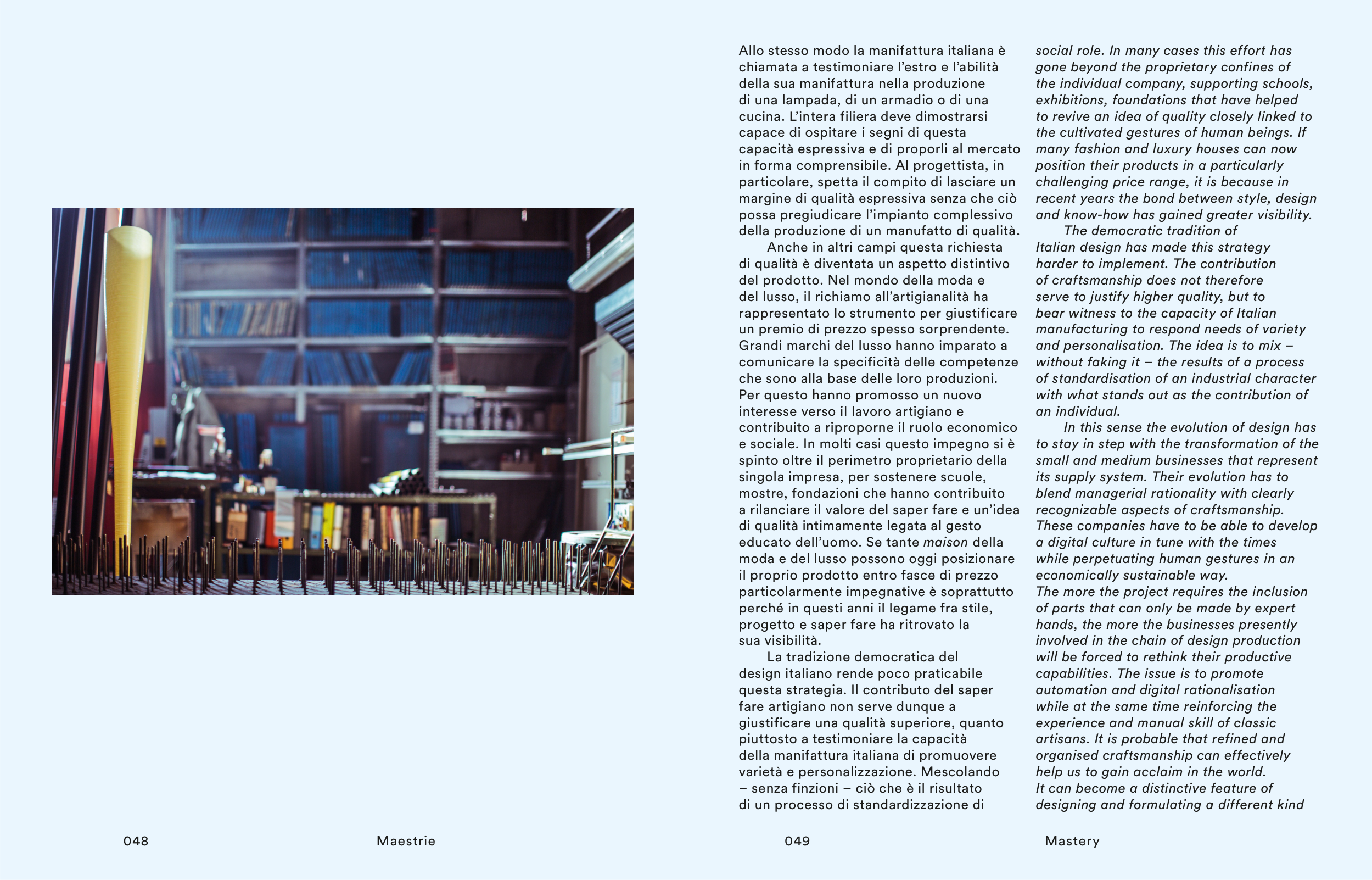Allo stesso modo la manifattura italiana è
chiamata a testimoniare l’estro e l’abilità
della sua manifattura nella produzione
di una lampada, di un armadio o di una
cucina. L’intera filiera deve dimostrarsi
capace di ospitare i segni di questa
capacità espressiva e di proporli al mercato
in forma comprensibile. Al progettista, in
particolare, spetta il compito di lasciare un
margine di qualità espressiva senza che ciò
possa pregiudicare l’impianto complessivo
della produzione di un manufatto di qualità.
Anche in altri campi questa richiesta
di qualità è diventata un aspetto distintivo
del prodotto. Nel mondo della moda e
del lusso, il richiamo all’artigianalità ha
rappresentato lo strumento per giustificare
un premio di prezzo spesso sorprendente.
Grandi marchi del lusso hanno imparato a
comunicare la specificità delle competenze
che sono alla base delle loro produzioni.
Per questo hanno promosso un nuovo
interesse verso il lavoro artigiano e
contribuito a riproporne il ruolo economico
e sociale. In molti casi questo impegno si è
spinto oltre il perimetro proprietario della
singola impresa, per sostenere scuole,
mostre, fondazioni che hanno contribuito
a rilanciare il valore del saper fare e un’idea
di qualità intimamente legata al gesto
educato dell’uomo. Se tante maison della
moda e del lusso possono oggi posizionare
il proprio prodotto entro fasce di prezzo
particolarmente impegnative è soprattutto
perché in questi anni il legame fra stile,
progetto e saper fare ha ritrovato la
sua visibilità.
La tradizione democratica del
design italiano rende poco praticabile
questa strategia. Il contributo del saper
fare artigiano non serve dunque a
giustificare una qualità superiore, quanto
piuttosto a testimoniare la capacità
della manifattura italiana di promuovere
varietà e personalizzazione. Mescolando
– senza finzioni – ciò che è il risultato
di un processo di standardizzazione di
social role. In many cases this effort has
gone beyond the proprietary confines of
the individual company, supporting schools,
exhibitions, foundations that have helped
to revive an idea of quality closely linked to
the cultivated gestures of human beings. If
many fashion and luxury houses can now
position their products in a particularly
challenging price range, it is because in
recent years the bond between style, design
and know-how has gained greater visibility.
The democratic tradition of
Italian design has made this strategy
harder to implement. The contribution
of craftsmanship does not therefore
serve to justify higher quality, but to
bear witness to the capacity of Italian
manufacturing to respond needs of variety
and personalisation. The idea is to mix –
without faking it – the results of a process
of standardisation of an industrial character
with what stands out as the contribution of
an individual.
In this sense the evolution of design has
to stay in step with the transformation of the
small and medium businesses that represent
its supply system. Their evolution has to
blend managerial rationality with clearly
recognizable aspects of craftsmanship.
These companies have to be able to develop
a digital culture in tune with the times
while perpetuating human gestures in an
economically sustainable way.
The more the project requires the inclusion
of parts that can only be made by expert
hands, the more the businesses presently
involved in the chain of design production
will be forced to rethink their productive
capabilities. The issue is to promote
automation and digital rationalisation
while at the same time reinforcing the
experience and manual skill of classic
artisans. It is probable that refined and
organised craftsmanship can effectively
help us to gain acclaim in the world.
It can become a distinctive feature of
designing and formulating a different kind
049
Mastery
048
Maestrie


